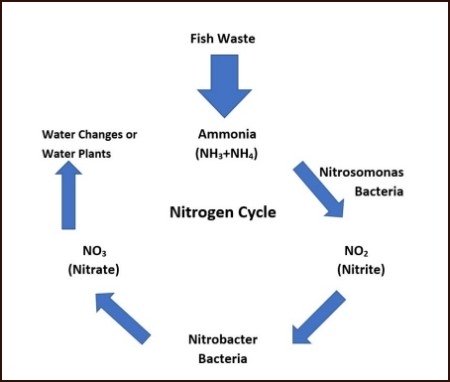| Back to Back Issues Page |
 |
|
The Goldfish Gazette, Issue #070-- The Nitrogen Cycle October 29, 2019 |
Goldfish Care TipsA Free Monthly Resource For Goldfish Enthusiasts In This Issue If your Goldfish aquarium or pond has a filter, you must be aware of how the nitrogen cycle works. The Nitrogen Cycle I have seen a number of posts on social media where the Goldfish owner has recently set up a new aquarium, stocked it with fish, and is wondering why they are all starting to show disease symptoms or worse, dying. A more worrying post had the owner explaining his aquarium was half way through the nitrogen cycle. The problem was the aquarium was fully stocked with very expensive Goldfish. This owner obviously knew about the nitrogen cycle, he just didn't understand that to go through this cycle, chemicals dangerous to fish life are produced. All experienced fish owners such as yourselves know about the nitrogen cycle, but in case there are any new Goldfish keepers reading this e-Zine, I will explain it. The nitrogen cycle is also known as the ammonia cycle, probably because ammonia is the first stage in the cycle. Ammonia SourcesAs we already know, fish produce ammonia from the decomposition of their waste and even from just breathing. Without filtration, ammonia will build up to a level where it is dangerous to fish life unless fish numbers in relation to water volume are extremely low.This level isn’t very high. At 0.50 to 1 PPM (parts per million) fish become distressed displaying clamped fins, lethargy and rapid gill movement. At 2-3 PPM fish begin to die. Any higher than this and you are in danger of losing most of your fish. An established aquarium or pond, with a filtration system working efficiently should have zero ammonia present. The Nitrogen CycleStage one – Ammonia is produced from decomposing waste and other dead organic material.Stage two – Nitrosomonas bacterial break down the ammonia into nitrites. Stage three – Nitrobacter bacteria break down the nitrites into nitrates. Stage four – Nitrates are removed from the water by plant life, or water changes. There are dangers in this cycle. At the ammonia stage we don’t want any measurable amount in the water. At the nitrite stage we again don’t want any measurable amount in the water as it affects fish in a similar way to ammonia by burning skin and gills, but also reduces the ability of the blood to absorb oxygen. At the nitrate stage the ammonia is now in its safest state, however we still don’t want nitrates to become too high as we now know they cause the blood vessels to dilate and the immune system is suppressed. Levels over 200 PPM are considered toxic. Bacteria CultureTo create an environment where a nitrogen cycle can occur, we need a large culture of nitrifying bacteria.These bacteria get to large numbers in filters because they are supplied with a continuous food supply, high oxygen levels and enough surface area to grow on. These conditions don’t occur in the aquarium naturally even though these bacteria are present. Bacteria numbers adjust to the bio-load of an aquarium, but not overnight. It can take weeks for a new aquarium filter to establish. The trick is to increase the bio-load in an aquarium gradually, allowing the bacteria to multiply as the food supply increases. It is pointless setting up a new aquarium, installing a filter, and expecting it to instantly manage the waste produced by the fish. It won’t, and this is why new aquariums will get an ammonia spike around two weeks after setup. It’s commonly called new tank syndrome. Water temperature plays a big part in the speed a filter will become established. In winter it will take two to three times as long compared to summer. We can cheat a little by using products such as API Stress Zyme that contain millions of living bacteria that seed the filter, speeding up the process considerably. One last consideration is the filter. Is it big enough for the job? Is the water flow going to be sufficient for the size of the aquarium or pond? Are you using the correct mix of filter media? Two things will tell you whether your filter is up to the task: If the water flow is sufficient, e.g. turning the water volume over around 4 times an hour, check that you are using the correct filter media. Bacteria need surfaces to grow on, and if you have insufficient or the wrong media in the filter, the bacteria won’t multiply to the required numbers. To learn more about filters, click here...
Comments? Ideas? Feedback? I'd love to hear from you. Just reply to this e-zine and tell me what you think, or what topics you want covered. Next Month's Topic Buying second handwww.facebook.com/aboutgoldfish |
| Back to Back Issues Page |